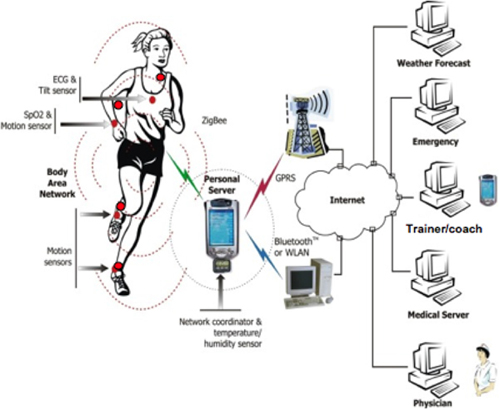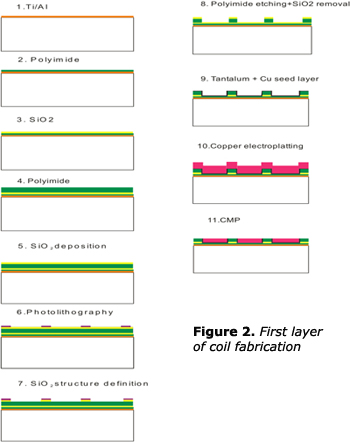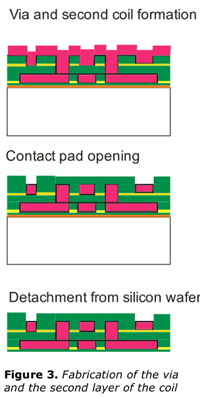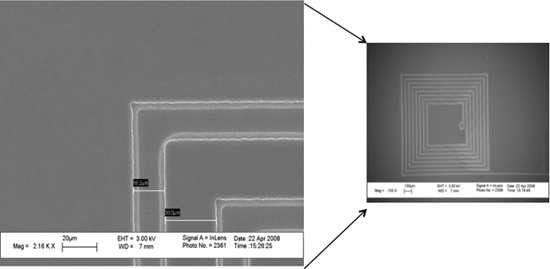Go to
Advanced WBSN
Advanced Wireless Body Sensor Networks (WBSN) for Performance Monitoring in Sports
Principal Investigator: Dr. Nadia Khaled (EPFL-IC-ISIM-LSI)
Co-investigator: Prof. Martin Gijs (EPFL-STI-IMT-LMIS2)
Overview:
The achievement of high-level athletic performance is increasingly associated to careful monitoring of all key metabolic and physiological functions, both during the effort and during the recuperation phases. To provide the necessary accurate, integrated and long-term assessment and feedback, the target wearable personal health system must sense, acquire, monitor and analyze a large number of physiological and metabolic parameters, both during physical activity and rest. Within this project, we investigate the design of such an advanced personal health monitoring system based on Wireless Body Sensor Networks (WBSN) technology.
More specifically, the WBSN will consist of a number of sensor nodes attached to the patient body. Each WBSN node ensures the accurate sensing and capture of its target physiological data, its (pre-) processing and wireless communication to the wearable Personal Digital Assistant (PDA).

Technical Activities and Results
 To achieve the technical challenges identified within the project, we have carried out activities along 4 main research lines. The following provides a summary of the main achievements therein.
To achieve the technical challenges identified within the project, we have carried out activities along 4 main research lines. The following provides a summary of the main achievements therein.
1. Efficient biomedical algorithms for embedded sensor nodes:
Pursuing the vision of smart sensor nodes able to reliably and efficiently perform embedded diagnosis, we have optimized two state-of-the-art automated electrocardiogram (ECG) delineation algorithms for real-time operation on a state-of-the-art commercial embedded sensor platform called SHIMMERTM. The two algorithms were carefully chosen as the most promising representatives of two relevant classes of ECG delineation algorithms, namely Wavelet transform-based and morphological transform-based. Our results1,2 demonstrated the feasibility of exploiting the limited processing and storage resources of a state-of-the-art embedded sensor platform to deploy real-time automated single-lead ECG signal analysis and diagnosis. We have further pursued multi-lead analysis as a means to improve the accuracy of ECG signal delineation. Several multi-lead alternatives were ported and validated on the SHIMMERTM platform3. These results were achieved through judicious application level optimization, taking into account the underlying hardware architecture and the real-time constraints of the automated analysis application. These results show the potential of embedding advanced processing and intelligence in sensor node to reduce the amount of wirelessly streamed data (i.e., only transmitting the relevant featured extracted from the sensed data or the diagnosis vs. wirelessly streaming the sensed signal for remote analysis), which would ultimately extend the lifetime of the personal ECG monitoring system in which they will be integrated. This last common conjecture is being evaluated through extensive hardware measurements. Furthermore, based on the extracted requirements of representative biomedical signal processing algorithms, as well as the shortcomings identified in the MSP430 processing module of the SHIMMERTM platform, we have initiated the design of an optimized sensor node processor.
 2. Energy-efficient air interfaces and MAC solutions:
2. Energy-efficient air interfaces and MAC solutions:
Using the IEEE 802.15.4 wireless connectivity available on the SHIMMERTM platform for WBSN-wide communications, this project investigated the design of an optimized MAC protocol for typical personal health monitoring applications. In particular, to accommodate node heterogeneity and potential asynchronous high-priority traffic (e.g. alarms or emergency alerts), we have studied the provision of service differentiation and traffic prioritization within the IEEE 802.15.4. To do so, we have investigated the extension of the state-of-the-art Markov-chain-based modeling of the slotted IEEE 802.15.4 MAC protocol to include service differentiation with an arbitrary number of nodes and traffic classes. In particular, we have presented this extension for the case of 2 traffic/sensor classes4. We are currently finalizing the general model and studying its use to assess the effectiveness of the various possible service differentiation mechanisms, as well as to design optimized traffic classes.
3. Tactile force sensor:
This activity focused on the realization of a thin and flexible sensor array based on the hybrid integration of a polymer layer containing embedded inductors with thin magnetic foils and a soft elastic polymer layer for transmission of force. The principle is based on inductive sensing by copper coils embedded in polymide. Planar copper coils are embedded in an elastic polyimide layer. Another soft polymer like PDMS is patterned and attached to the device. High permeability magnetic foils are sandwiching the Cu coils in the final design. When a normal force or shear force is applied on the sensor, the PDMS layer is sensitive to the force and a change in the distance between the coils and the foil will change the inductance. A variety of applications exist for a tactile sensor like biomechanics research, clinical evaluations of hand functions and hand rehabilitation. It is also an essential tool for developing biomechanical modeling and predicting stress on muscles. Technological advances have already provided small and thin sensors. Silicon-based force sensors offer miniaturization, but they are not useful as they are packaged in bulky plastic cages and lack overload protection.
Figure 1 and 2 show the developed process flow for the fabrication of copper micro coils embedded in polyimide. A thin layer of Ti-Al layer of thickness 500/1000 nm is deposited for enabling later anodic dissolution and detachment of the coil. 10 um of polyimide PI2611 is spin-coated with a soft bake at 90°C and then curing in a nitrogen atmosphere at 200° C for 1 hour. No adhesion promoter is required, as the Ti-Al layer will help in good adhesion of PI2611.

Following this, 500 nm of SiO2 is sputtered and 5 um of PI2611 is spin coated. Again a 500 nm of SiO2 is used as a mask and patterned. AZ1512 is spin coated on the oxide layer. In order to enhance the adhesion of resist HMDS is coated in YES LPII. The polyimide will etch until it encounters oxide etch stop layer as seen in Figure 1. The etching of PI2611 is made in a CF4 plasma for 5 min. The resist would be stripped while removing the PI. 40 nm of Ta and 200 nm of sputtered Cu is used a seed layer for electroplating of copper. 7 um of copper is then electroplated, while the current is kept at a low level in order to have uniform deposition.
The copper lines are defined by performing a chemical mechanical polishing (CMP). After CMP, a thin seed layer is deposited in order to protect the copper from diffusion. The via and second layer of coil fabrication follows the principle of a dual damascene process, as shown in Figure 2. A Scanning Electron Microscopy photograph of the first layer of an electroplated Cu coil is shown in Figure 3.
Publications
1. N. Boichat, N. Khaled, F. Rincón and D. Atienza, “Wavelet-Based ECG Delineation on a Wearable Embedded Sensor Platform”, In the Proc. of Intl. Workshop on Body Sensor Networks, Feb. 2009.
2. F. Rincón et al., “Implementation of an automated ECG-based diagnosis algorithm for a wireless body sensor platform”, In the Proc. of Intl. Conference on Biomedical Electronics and Devices, Jan. 2009.
3. F. Rincón et al., “Multi-lead wavelet-based ECG delineation on a wearable embedded sensor platform”, to appear in the Proc. Of Computers in Cardiology, Sep. 2009.
4. E. D. Ngangue Ndih, N. Khaled and G. De Micheli, “An analytical model for the contention access period of the slotted IEEE 802.15.4 with service differentiation”, in the Proc. Of IEEE Conf. on Communications, Jun. 2009.
